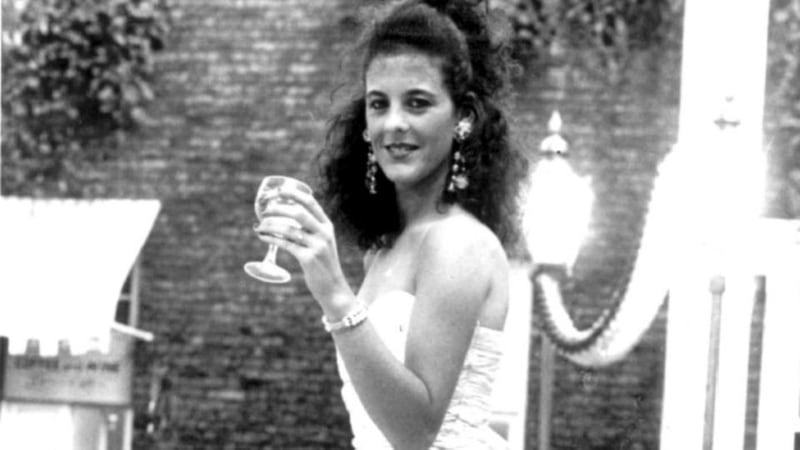For every applicant for a shop floor job in Brown Thomas, there are hundreds who want to skate straight in as a fashion buyer. Ideally in a flippy skater skirt by Alaia.
Shelly Corkery is wearing one. It's black, worn with a St Laurent tuxedo, a white Balenciaga T-shirt and little gold-studded ankle boots by St Laurent. The wallet is a black Hermes "Constance". The metal- strapped watch tapping phone alerts to her wrist is an iWatch.
At full retail prices, the lot combined could probably pay for a decent car.

So you could deliver a treatise on the transience of fashion and its skewed values. Or feel impelled to run up your own tuxedo for a tenner just to show them. Or since you’re here anyway, in a dimly lit, Diptyque-scented marketing office, you could just surrender to the pleasure of looking at Shelly Corkery.
There are very few people who would put a T-shirt with a tuxedo and a sticky-out skirt and pull off a look that is cool and beautiful, playful and businesslike, the polar opposite of the perma-tanned bling queen style. There is art in that. And there is art in the individual pieces: perfect examples of form and function, down to the plain T-shirt with the just-so neckline and fabric weight.
Anyway, the point is that it's a plain old Thursday afternoon, Corkery is going nowhere special, and she's still dressed like that because it's her job. And she has nice, stylish assistants looking out for her, putting deferential heads around the door to offer coffee and reschedule appointments and lining up her diary so she gets back from Milan in time for a Sardinian holiday with her partner, Paul Kelly – chief executive of Selfridges of London, overlord of the Weston retail fashion empire (which includes Brown Thomas) – and their 13- year-old daughter, Cameron.
So, naturally, everyone wants Corkery’s job. With one hand hovering about an inch above the table to indicate the tiny pile of applications for the shop floor, and the other about four feet higher indicating the buyer hopefuls, she explains why the applicants in the high pile have it all wrong.
You have to be humble. "You cannot buy unless you know the business," Corkery says. "You cannot understand the business unless you work on the floor for a couple of years at least". Forget the courses and the year of study. "Get on the floor. Learn everything. Suck it all up. Talk to all the buying teams. Then apply for a job."
When Corkery arrived in Brown Thomas, she had already been a highly respected, innovative buyer in the Design Centre for more than 10 year. But even she had to start again on the floor, shifting furniture like everyone else. "I would do anything. I wanted to know everything. And in this business, you have to know everything".
Galen Weston, the Weston patriarch, told her she needed to understand just one thing about the job. "You're going to buy – and you're going to sell". Simple, but not easy. The Weston family did not get rich by running businesses at a loss. And Corkery wasn't employed just to look good.
At 8am every Monday, she is in the store studying the previous week’s sales, before tackling all the figures at a trade meeting.
"I would really have a problem with something not selling," she says. "Say we didn't sell something in Alaia or Victoria Beckham one week. That would be a massive problem. Because with such a brilliant brand, it has to mean that there was either no staff on the floor, or they closed the department, or the stock was all hanging off the rail, filthy dirty, all torn with the buttons hanging off . . . "
How would she deal with that? “I’d say ‘did you close the department? Have you pulled down the shutters?’ They just laugh.” But? “But they’re on it.” I bet they are.
“The bottom line is you want to get your sell-through. That means say, if we spend €10,000 on a brand which has a retail of €26,000, we need to sell over half of that to get a good sell-through. You only get your money back if you sell half.”
To illustrate, she points to an orange coat on an autumn/winter 2015 mood board. “I would buy it off the designer for say, €500. Then you mark it up, sell it, for maybe €1,500. It’s that simple”.
Simple, yes, but only if the fashion director gets it right in the first place and women learn to want a very expensive orange coat (which is another story).
Shelly Corkery is clearly besotted with fashion. Equally, her singular position in this country’s fashion constellation owes as much to her tenacious, disciplined, commercially driven brain.
On buying trips for 16 weeks a year, Corkery takes big, daily gambles. “It’s a very high-risk business because you’re buying top-end fashion, top-end trend, at top-end prices. I’d have to know what is happening and have it before anyone else is thinking about it.”
And that’s a whole other skill. Staying in cool, boutique hotels such as New York’s Soho Grand and dining in ABC Kitchen, where there will be hugs from Victoria Beckham (the Beckhams dine en famille in ABC on launch nights), are the sweet downtimes after the 3.45am starts, red-eye flights and frantic gallop around the shows.
The shows are long, rushed days of sniffing out the fashion shifts, chatting with other buyers (when a hot new designer such as Beckham swims onto her radar, Corkery will chase her relentlessly) and conducting a sweep of “every single department store” in New York City.
And she does it all in heels: Louboutin Pigalles, six inches of stiletto and a pointy toe. "You're mixing with all the other teams and directors of all the stores in the world and you don't want to look casual." Corkery calls today's 2-inch ankle boots "flats".
As a fashion director in Dublin, her job has a personal side to it. It’s what differentiates the Brown Thomas customer base from say, Selfridges’. In London, ready- to-wear is hugely tourist-driven; in Dublin, it’s almost entirely local.
“We know who we’re buying for,” she says. That means Corkery has seen a lot of individuals rise and fall, close-up. She recalls when people were buying four handbags at a time.
“Then developers, car garages, people like that were hit very badly . . . We had to plan our budgets accordingly. We couldn’t buy eight Celine coats at €4,000 or whatever they were anymore because we couldn’t sell them, so we went go from buying eight to three or six to two”.
For those who still had the money but were afraid to flaunt it, the whispering discretion of the store’s personal shopping service was a godsend.
"Anyone seen on our floor was obviously shopping for luxury goods," Corkery says, "so personal shopping became really strong. People are not seen, they don't have to take any bags with them, and it's all done behind closed doors. After the Celtic Tiger, a lot of people didn't have it anymore and a lot of people put it away. That's the way the world is . . . "
That continued buoyancy is partly why, four years ago in the depths of the downturn, she and the general manager, Stephen Sealy, Paul O'Connor and Cathy Murray in beauty had the vision and courage to push for the €9 million transformation of the accessories and beauty floor. That's complete now. Chanel is busily upgrading and Hermes will soon be doing the same.
For most people, those brand names define a parallel universe of ease and luxury to which they can never aspire. Corkery’s job it is to wear, buy and promote her employer’s luxury goods, and she is upfront about her own love of luxury. But she talks with feeling about the lessons of the crash, especially for those now in the 30 to 40 age group. Does she think people have changed?
“I hope to God they’ve learned,” she says, and seems to mean it. “I do think people are more savvy. No one is coming in and buying four bags now. They’re buying the bag they love and being more intelligent about what they’re buying.
“The price point isn’t the issue for us. It’s more buy what you love. Invest in one beautiful coat rather than three cheaper ones.”
Corkery's current focus is on young Irish designers. The project (there is always a project) is to find them, support them and keep them at home. Expect to see the windows full of them come July 6th, when "Create" kicks off and the names of 50 Corkery-picked Irish designers are carried throughout the store, including collections from veterans Mariad Whisker and Vivienne Walsh.
In a sense, it takes her back to the old days in the Design Centre, when John Rocha, Michael Mortell and Quinn & Donnelly were the brilliant newcomers, and further back to her own childhood in Cork city, one of five children of a "fashion addict" mother who ran her own successful fashion shop . That was before her father lost patience with his wife's absences on buying trips and the shop had to go.
Corkery reckons she inherited her decisiveness and straight-talking style (there is not a hint of pretentious fashion luvvie in her machine-gun delivery ) from her father, an electrical engineer. He was only 66 when he died, in mid-conversation with Shelly at the Curragh racecourse. Her mother died the same year, of pancreatic cancer and a broken heart.
Now Corkery has a daughter to steer through the slalom of entitlement that befell many a sullen teenager in the bubble, the kind seen pouting in BT cafes, armed with their own credit cards and a slew of designer bags.
“I’m very lucky to have so many nice things because it’s part of my job,” she says. “But my daughter doesn’t. She has three pairs of jeans from Bonpoint that we do in the store, and will probably be moving on soon, down the Abercrombie or Hollister route. But she’s a very unassuming child and has a very happy disposition, is totally focused on her schoolwork and her sports. So I’m very lucky, touch wood.”
While Cameron’s mother ploughs her own furrow, her father works five days in London and comes back for weekends. Venus, their live-in child carer, moves out at the weekend and the three live a quiet life, which, Corkery claims, never includes office talk. It’s been like that for 13 of the couple’s 15 years together.
Is a two-in-seven-day relationship hard to sustain? "It's the best", she whoops. "You have so much to talk about at the weekend."
Now it’s off for a meeting about the Marvel Room (another baby of hers), a meeting “to put Create to bed”, a travel planning meeting with the buyers, and another about Milan.
And then the holidays: "Vegetating in Sardinia in a beautiful hotel," Corkery says happily.
Though there is talk of gym and tennis, of course. And if people want to ring her about work, that’s no problem at all.






